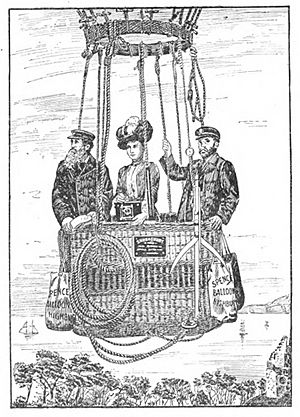Gertrude Bacon facts for kids
Gertrude Bacon (born April 19, 1874 – died December 22, 1949) was an amazing English pioneer in flying. She was one of the first women to achieve many things in aeronautics, which is the science of flight. Gertrude also made important discoveries in astronomy (the study of stars and planets) and botany (the study of plants). She helped make flying popular through her books and encouraged women to get involved in aviation.
Contents
Early Life and Learning
Gertrude Bacon was born in Cambridge, England. Her father was John Mackenzie Bacon, a well-known astronomer and scientist. Her mother was Gertrude Myers. When Gertrude was two years old, her family moved to Cold Ash, a village near Newbury.
Gertrude's father taught his children at home. This meant Gertrude learned a lot about science from him. She also spent a short time studying at The Maynard School in Exeter.
Working with Her Father
Gertrude became her father's helper in both astronomy and aeronautics. She was one of the first members of the British Astronomical Association (BAA). She also joined the British Science Association, which helps advance science.
Exploring the Stars: Astronomy
Gertrude joined her father on exciting trips to see total solar eclipses. These are times when the Moon completely blocks the Sun. They traveled to far-off places like Vadso, Lapland, in 1896.
Their first trip was not successful because of cloudy weather. But their next trips were much better! They saw eclipses in Buxar, India, in 1898 and Wadesborough, North Carolina, in 1900.
Pioneering Flight: Aeronautics
Gertrude was very interested in aeronautics, the study of flight. In 1898, she became the first woman in England to go up in a proper balloon. She flew with her father.
Daring Balloon Flights
One of her most exciting balloon flights happened on November 15, 1899. Gertrude and her father, John Mackenzie Bacon, went up with Stanley Spencer. They wanted to watch the Leonid meteor shower from high above the clouds. Ten hours later, they landed safely near Neath, South Wales. It was a close call, as they almost drifted out over the Atlantic Ocean!
Firsts in Airships and Airplanes
Gertrude was not scared by this adventure. In August 1904, she flew with Stanley Spencer again. This time, they were in an airship that he designed. This made Gertrude the first woman to fly in an airship.
She is also known as the first Englishwoman to fly in an airplane. On August 29, 1909, Roger Sommer took her up in a Farman biplane. This happened during a big aviation event in Rheims, France. She also flew in a 'Big Bat' monoplane with Douglas Graham Gilmour in 1910.
First Seaplane Passenger
Gertrude was even the first passenger in a seaplane. In mid-1912, she flew with pilot Herbert Stanley Adams over Windermere. Adams had made the first successful flight from water and back again in Britain in 1911.
Gertrude helped make flying popular through her books and public talks. She encouraged many people to learn about aviation.
Discovering Plants: Botany
In 1901, Gertrude joined the Wild Flower Society. This added botany, the study of plants, to her many interests.
On July 23, 1923, Gertrude Bacon and Lady Joanna Charlotte Davy made an important discovery. They found a rare plant called Carex microglochin, or Bristle Sedge, in Great Britain for the first time.
In 1929, Gertrude Bacon married Thomas Jackson Foggitt. He was also a botanist and a chemist. Gertrude outlived him by 15 years.


